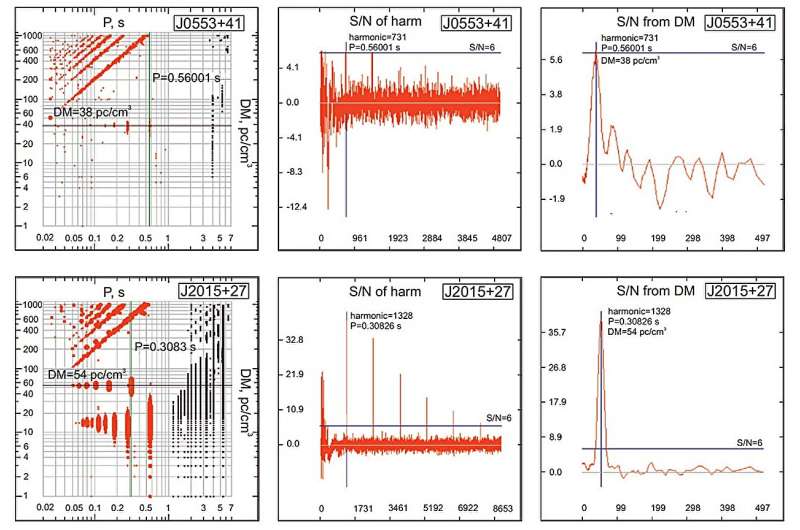January 29, 2024 report
This article has been reviewed according to Science X's editorial process and policies. Editors have highlighted the following attributes while ensuring the content's credibility:
fact-checked
peer-reviewed publication
trusted source
proofread
Russian astronomers discover dozens of new pulsars

A team of Russian astronomers from the Pushchino Radio Astronomy Observatory (PRAO) and elsewhere, reports the detection of 39 new pulsars as part of the Pushchino Multibeams Pulsar Search (PUMPS) project. The finding was detailed in a research paper published January 9 in the Monthly Notices of the Royal Astronomical Society.
Pulsars are highly magnetized, rotating neutron stars emitting a beam of electromagnetic radiation. They are usually detected in the form of short bursts of radio emission; however, some of them are also observed via optical, X-ray and gamma-ray telescopes.
Now, a group of astronomers led by PRAO's Sergey Tyul'bashev has detected 39 new pulsars. The discovery was made using PRAO's Large Phased Array (LPA) radio telescope at a frequency of 111 MHz.
"Daily round-the-clock observations were carried out for about 3,000 days. The duration of the observation session for each direction in the sky was 3.5 minutes per day. The search for pulsars was carried out using power spectra. To search for weak pulsars, power spectra were summed up," the researchers explained.
As a result, the team identified 330 pulsars with regular radiation in the blind search of the area at declinations between -9 and +55 degrees, using summed up power spectra. Of this sample, 39 pulsars have not been reported before.
The newfound pulsars have spin periods between 0.033 and 3.74 seconds, while their dispersion measures range from 13 to 145 pc/cm3. Therefore, the median values for the spin period and dispersion measure were calculated to be 0.9 seconds and 43 pc/cm3, respectively.
When it comes to the large sample of all 330 identified pulsars, the astronomers noted that at least several of them may showcase variation of their observed properties. Some of them may be the so-called rotating radio transients (RRATs)—a subclass of pulsars characterized by sporadic emission.
The nature of RRATs is still unclear. In general, it is assumed that they are ordinary pulsars that experience strong pulses. So far, only slightly more than 100 RRATs have been found, therefore astronomers are interested in detecting more transients of this type in order to characterize them and improve our knowledge about their nature.
Summing up the results, the authors of the paper underlined the high sensitivity of their search for pulsars with spin periods in the range of seconds.
"We declare that we have one of the highest [sensitivities] in the world when searching for seconds pulsars in the meter wavelength range. (...) This sensitivity can be an order of magnitude better than the sensitivity achieved in the LOTAAS survey conducted on LOFAR at the frequency of 135 MHz," the scientists concluded.
More information: S A Tyul'bashev et al, Pushchino multibeams pulsar search. IV. Detection of new pulsars at declinations −9o < δ < +55o., Monthly Notices of the Royal Astronomical Society (2024). DOI: 10.1093/mnras/stae070. On arXiv: DOI: 10.48550/arxiv.2401.10706
Journal information: Monthly Notices of the Royal Astronomical Society , arXiv
© 2024 Science X Network


















